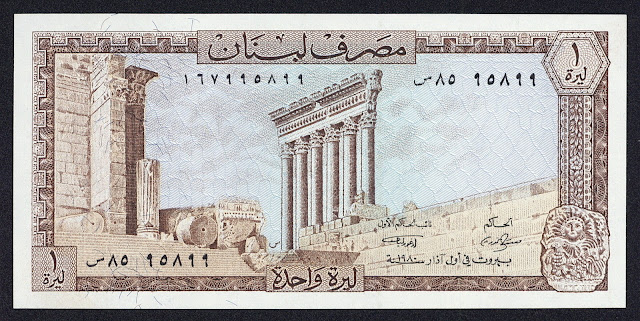Currency of Lebanon 1 Livre banknote 1980
Bank of Lebanon - Banque du Liban
Lebanon Banknotes - Lebanon Paper Money
Obverse: Ruins of Corinthian columns of the Roman Temple of Jupiter in Baalbek, Lebanon. Denomination is in Arabic numeral.
Reverse: Stalagmites, stalactites, and underground river in lower grotto of Jeita Caverns. Denomination in words is in French language.
Main colors: Brown, tan, and blue.
Watermark: Two eagles.
Dimensions: 135 x 65 mm.
Printer: Thomas De La Rue & Company Limited, London, England.
Lebanon Banknotes - Lebanon Paper Money
1964 - 1993 Issues
On 1 August 1963 decree No. 13.513 of the “Law of References: Banque Du Liban 23 Money and Credit” granted the Bank of Lebanon the sole right to issue notes in denominations of 1, 5, 10, 25, 50, 100, and 250 pounds, expressed in Arabic on the front, and French (livres) on the back. All of these notes have security fibers embedded in the paper, though the location of them varies from right to left, and front to back, on different denominations.
1 Livre 5 Livres 10 Livres 25 Livres 50 Livres 100 Livres
Temple of Jupiter
The Temple of Jupiter itself originally had 54 columns, but it was destroyed by Theodosius and pillaged by Justinian and only 6 Corinthian columns survive. The architrave and frieze blocks weigh up to 60 tons each, and one corner block over 100 tons, all of them raised to a height of 19 m (62.34 ft) above the ground. Individual Roman cranes were not capable of lifting stones this heavy, but combining multiple cranes may have enabled them to rise to this height. They may also have alternated sides a little at a time, filling in supports underneath each time. The Julio-Claudian emperors enriched its sanctuary in turn. In the mid-1st century, Nero built the tower-altar opposite the temple. In the early 2nd century, Trajan added the temple's forecourt, with porticos of pink granite shipped from Aswan at the southern end of Egypt. A westward-facing basilica was constructed over the temple's ruins during the reign of Theodosius.
Jeita Grotto
The Jeita Grotto is a system of two separate, but interconnected, karstic limestone caves spanning an overall length of nearly 9 kilometres (5.6 mi). The caves are situated in the Nahr al-Kalb valley within the locality of Jeita, 18 kilometres (11 mi) north of the Lebanese capital Beirut. Though inhabited in prehistoric times, the lower cave was not rediscovered until 1836 by Reverend William Thomson; it can only be visited by boat since it channels an underground river that provides fresh drinking water to more than a million Lebanese.
In 1958, Lebanese speleologists discovered the upper galleries 60 metres (200 ft) above the lower cave which have been accommodated with an access tunnel and a series of walkways to enable tourists safe access without disturbing the natural landscape. The upper galleries house the world's largest known stalactite. The galleries are composed of a series of chambers the largest of which peaks at a height of 120 metres (390 ft).
Aside from being a Lebanese national symbol and a top tourist destination, the Jeita grotto plays an important social, economic and cultural role and is a finalist in the New 7 Wonders of Nature competition, and as of 7:44 pm GMT the provisional New7Wonders of Nature based on the first count of vote results on 11/11/11 Jeita was one of the top 14 Finalists in the New 7 Wonders of Nature.

